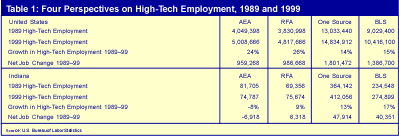Defining High-Tech Jobs: A Response to Cyberstates
Every year, the American Electronics Association (AEA) releases a set of rankings (Cyberstates) that attempt to rate the high-tech nature of each state through change in the number of jobs, exports, R& D funding, etc. This article focuses on the jobs that are included and excluded in their definition of high-tech. Essentially, AEA's high-tech jobs definition is restricted to the electronics industry - but this is misleading. Among just a few of the technology sectors not included in the AEA definition, but which are included in other reports and studies from creditable non-profit and government organizations, are:
- Industrial Inorganic Chemicals
- Drugs (pharmaceuticals)
- Industrial Organic Chemicals
- Agricultural Chemicals
- Engines & Turbines
- Motor Vehicles & Equipment
- Aircraft & Parts
- Guided Missiles, Space Vehicles & Parts
- Medical & Dental Laboratories
- Engineering & Architectural Services
- Research & Testing Services
Considering the industry mix in Indiana that includes all of the sectors above, the AEA rankings can distort the high-tech jobs picture for Indiana. One of the more glaring examples is the omission of a cutting-edge company, Eli Lilly (which is in the process of adding 7,500 knowledge-based jobs to Indiana) or the Warsaw Cluster, considered the "Orthopedics Capital of the World."
If we are to accept AEA's definition of high-tech, there is yet another important statistic in that report: Indiana's loss in these electronics jobs came almost entirely between 1994 and 1998. According to this study, Indiana generated 1,500 high-tech jobs between 1999 and 2000. Some of the job losses Indiana has sustained are being overcome by technology jobs at companies such as Virtual Financial Services, Powerway, RealMed, Interactive Intelligence, and Aprimo.
Last year, when the 2000 rankings from AEA came out, the Indiana Department of Commerce took an in-depth look at studies by a consulting group (RFA), an information provider (One Source) and a research group (Bureau of Labor Statistics). Bottom line: depending on whose statistics and categories you use, the result is drastically different (see Table 1).
Click on table to view printable, zoomable PDF.

- According to the AEA, Indiana lost almost 7,000 high-tech jobs between 1989 and 1999.
- According to RFA, we gained more than 6,300.
- One Source found that Indiana gained nearly 48,000 high-tech jobs over that time span.
- The Bureau of Labor Statistics showed Indiana gaining just over 40,000 high-tech jobs.
These studies were more inclusive in their definition of high-tech. What is needed is an agreed upon definition of high technology, not what a trade association wants it to be. The AEA study shows us what is happening in a given state's electronics sector, but it is simply not accurate to equate that to a state's high-tech economy.
